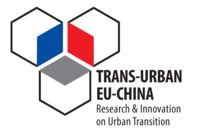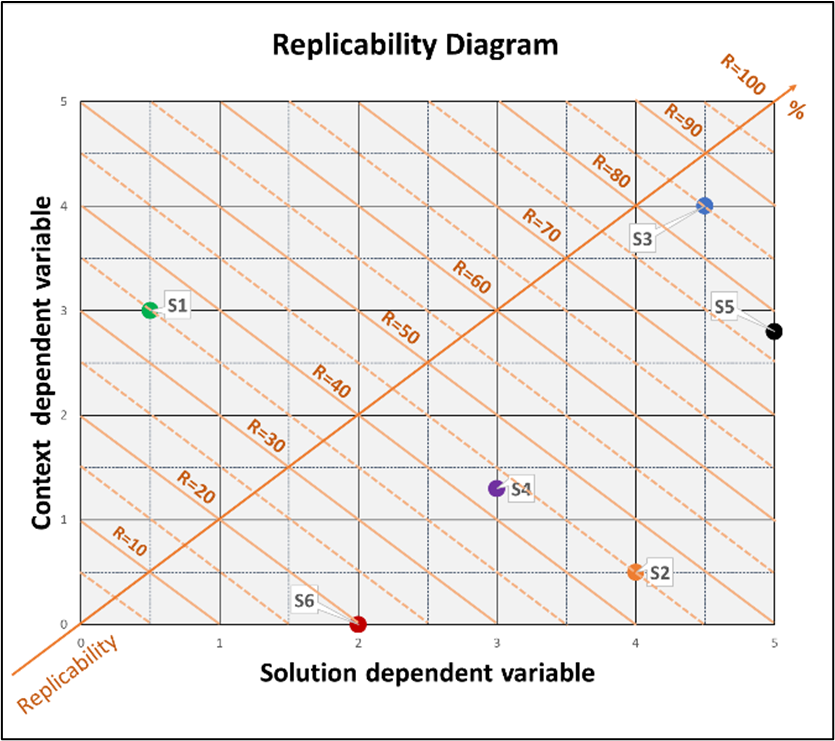
TRANS-URBAN-EU-CHINA
Transition towards urban sustainability through socially integrative cities in the EU and in China
SITEE REPLICABILITY TOOL
1. Purpose(s)
Replication and Upscaling mechanisms are important from the point of view that pilot projects should not remain a “one-off” exercise. Aiming to ensure a successful implementation, there is no one size fits all approach. Local conditions can have a strong impact and expose a range of barriers as well as enablers. While numerous approaches and technologies address urban challenges, the processes of urban road-mapping and vision development remains complex. In many cases successfully implemented solutions that work in one urban context, fail dramatically when transferred in another urban setting. It is risky and not sufficient to attempt to copy-paste an existing solution from one to another urban environment, as diverse local factors may counteract the well-intended aims.
Therefore, it is necessary to follow a range of principles and guiding steps that are necessary to identify the most replicable urban solutions matching different urban contexts. The SITEE Replicability Methodology is a tool that enables the evaluation of replicability potentials.
SITEE is a decision support tool able to determine the replication potential of different urban solutions in a specific place, taking into account the full range of local factors that could influence their applicability, with the ambition to support cities in the selection of the most suitable solutions for their local context.
The approach is based on the analysis of 5 dimensions: Sociocultural; Institutional; Technological; Environmental and Economic – SITEE replicability tool.
Functions:
SITEE relies on a mathematical approach that can be easily represented through cartesian diagrams built on variables dependent on:
- factors that characterize the solution itself (horizontal axis)
- factors that are inherent to the local context (vertical axis).
According to those variables, every solution can be represented as a point in the diagram (See Figure 1).
The correlation with the replication potential, expressed on a scale 0-100%, is given by the intersection between the points representing the solutions and the iso-replicability lines (diagonal lines in the figure).
In SITEE, different Solution and Context variables are associated to every dimension (Table 1) and the general approach explained above is likewise applied to each of them.
The Context Variables are informed through questionnaires addressed to institutions, stakeholders, citizens from the city targeted for replication, while the Solution Variables should be elicited from the industrial/private entities and local administrations who implemented the solutions or, alternatively, can be obtained through desk research activities and experts’ estimations.
Once all variables are calculated, a Replicability Diagram can be obtained for each dimension and the five values of replication obtained are then averaged to estimate the Overall Replication Potential of the selected urban solutions in the specific context under assessment (e.g. city, district, etc.) (Figure 2).
Besides the Overall Replication Potential, a Replication Priority Index has been defined to rank solutions from the most to the least replicable. The Replication Priority Index is calculated by expanding the measurement scale of the Overall Replication Potential while keeping proportions and ratios among the different replication values unchanged. It is thus possible to detect and better visualize even minimal differences among solutions, therefore facilitating the analysis (Figure 3).
This multi-dimensional assessment allows for the identification of the most relevant factors that may limit or facilitate replication, supporting cities in the selection of those urban solutions that could be best replicated according to the socio-cultural, institutional, technological, environmental and economic aspects proper of their local context.
Key Words: replication, urban solutions; social; socio-cultural; institutional; environment; economic; technology; method; replication potential
2. Relevance and Impact
SITEE adopts a bottom-up approach, as it deals with the replication of individual measures and, therefore, does not allow the replication potential of integrated policies to be directly evaluated. However, individual measures are analysed by explicitly considering the context in which they are embedded and can thus be seen as useful building blocks towards a more systemic appraisal. Moreover, it must be pointed out that this horizontal approach can be applied to a wide range of urban solutions, from nature-based, going through technology based, including those pursuing social inclusiveness.
Test activities in Wuhan
In order to validate the methodology, it was decided to test it in one of the Urban Living Labs of the project by engaging the city of Wuhan and CAS as local reference and contact point of the city.
The scope of the work was to estimate the replication potential of a set of European Urban Solutions in the city of Wuhan. The results of this test was relevant for the validation of this new method and for the identification of areas for further improvement of the whole process with the ambition to build a solid and robust approach for estimating replicability that could be extended to other Chinese cities.
The testing activities carried out in this experimentation provided for:
- identification of criteria for selection of urban solutions (including 12 criteria of socially integrative cities);
- selection of urban solutions;
- calculation of the Solution Variables required;
- preparation and distribution of the questionnaire for collecting the Context Variables;
- running of the tool;
- elaboration and analysis of results with a focus on Chinese context
Key Findings and Conclusions
The analysis carried out provides a good basis for drawing general conclusions both on the method itself and on potential further applications in China.
A first important conclusion is that SITEE is not only a means of prioritization of urban measures in support of decision-making process but can provide valid suggestions for improvement whenever weaknesses, that could hinder the application of potentially winning solutions, are found in the local context.
Furthermore, the application of this methodology is well suited to the comparison between cities, as crucial aspects for replication can emerge more clearly from comparative assessments. (details on the results are reported in D2.3 and in Chapter 14 of the book Paolucci L. “Estimating the Replication Potential of Urban Solutions for Socially Integrative Cities”, Chapter 14 from the book “Towards Socially Integrative Cities”, Muller B. et al)
Potential application in China
The application of SITEE to the Chinese context might have interesting implications. The China’s city-tier classification system can be adapted to SITEE so as to broaden and maximize the results and the impacts that can be obtained for one city, leading to the identification of a group of solutions that can be a valid option for all the cities belonging to the same tier.
Connecting cities
Identifying cities that have implemented solutions which, thanks to SITEE, turn out to be highly replicable and promising in other cities could offer ideas and inspiration, offering new opportunities that had never been considered before. In this regard, SITEE could support cities in the identification of similar local realities with whom making twinning, opening a dialogue and discussing potential collaborations. This exchange of knowledge and experiences is a fundamental step in the replication process.
3. Strenghts
- Flexibility: the flexibility in setting indexes and variables represents a powerful means for evaluating replicability in any local context and can produce effective results both when assessing EU measures to be potentially applied in the Chinese context, as well as the opposite case, or even when considering any other city outside Europe and China.
- Modular approach: SITEE is a very versatile method which, thanks to its modular nature, allows for additional adaptations and extensions to other dimensions whenever necessary. In this regard, future investigation on how to add the health dimension will be done.
- Horizontal approach: SITEE can be applied to a wide range of urban solutions, from nature-based, going through technology based, including those pursuing social inclusiveness.
- City Comparison: the assessment of the same group of solutions could lead to different results in other cities with diverse characteristics. This is possible and can be easily done in SITEE by varying the values of the context variables obtained from other cities, while keeping the solution variables unchanged.
4. Weaknesses
- Data collection: Data collection procedures can be difficult and time-consuming. It is not easy to obtain the required information and input data from cities and experts of the urban solutions involved in the analysis.
- Individual measures: SITEE adopts a bottom-up approach, as it deals with the replication of individual measures and therefore does not allow to directly evaluate the replication potential of integrated policies. However, individual measures are analysed by explicitly considering the context in which they are embedded and can thus be seen as useful building blocks towards a more systemic appraisal.
5. Good practice examples
SITEE is an experimental tool that was developed by ISINNOVA during the second year of the project TRANS URBAN EU CHINA.
6. Further helpful study material
- The full report on results and analysis of the test done in the city of Wuhan is reported in
- D2.3 “Set of practical tools and mechanisms tested and validated in the Living Labs for the development of sustainable cities, integrative planning and implementation”.
- The methodology is explained in detail in the article “Estimating the replication potential of urban solutions for socially integrative cities” (Paolucci L., 2020), published in the book “Towards Social Integrative Cities”
7. References
(Döllner, Baumann and Buchholz 2006), J. Döllner, K. Baumann, H. Buchholz, 2006, Virtual 3D City Models as Foundation of Complex Urban Information Spaces. 11th international conference on Urban Planning and Spatial Development in the Information Society (REAL CORP), (Manfred Schrenk, ed.), CORP – Competence Center of Urban and Regional Planning, pp. 107–11.
(Dorcas Wong 2019), Dorcas Wong, February 2019, China’s City-Tier Classification: How Does it Work?, China Briefing.
(EC DG ENERGY 2016), EC DG ENERGY, June 2016, Analysing the potential for widescale roll out of integrated Smart Cities and Communities solutions.
(García-Fuentes M. et al., September 2016), Miguel Á. García-Fuentesa, Ana Quijano, Cristina de Torre, Rubén García, Philippe, Compere, Christelle Degard, Isabel Tomé, European cities characterization as basis towards the replication of a Smart and Sustainable Urban Regeneration Model, Energy Procedia 111 (2017) 836 – 845, Science Direct.
(Hargrave 2020), Marshall Hargrave, April 2020, Weighted Average Cost of Capital – WACC, Investopedia- Corporate Finance & Accounting.
(Hayes 2020), Adam Hayes, April 2020, Internal Rate of Return – IRR, Investopedia- Corporate Finance & Accounting, ISO 21007‑1:2005, 2.30.
(Müller B. et al., March 2019), Müller B., Schiappacasse P., Baojun Yang, Chang Liu. March 2019, Workshop Report on “Theoretical aspects of transition towards urban sustainability and the role of socially integrative cities”, Deliverable of TRANS-URBAN-EU-CHINA project.
(Ross 2020) Sean Ross, April 2020, Cost of Capital vs. Required Rate of Return: What's the Difference?, Investopedia- Corporate Finance & Accounting.
(Xing Lijuan, 2017), Xing Lijuan, To judicialize the eco-civilization policy in china: a perspective of grasslands protection, 2017, http://law.ku.edu/sites/law.drupal.ku.edu/files/docs/law_journal/v26/12%20Xing%20-%20Eco-civilization%20Policy%20in%20China.pdf.
8. Author(s) of the article
Loriana Paolucci (ISINNOVA)



